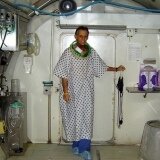Blast Injury and Hyperbaric Oxygenation
Featured article. Page 5.
Acute Brain and Cardio-Respiratory Dysfunction After Blast/Blunt Injuries: The Life-Preserving Effects of Hyperbaric Oxygenation
Gennady G. Rogatsky and Avraham Mayevsky
The Mina & Everard Goodman Faculty of Life Sciences and the Leslie and Susan Gonda Multidisciplinary Brain Research Center, Bar-Ilan University, Ramat-Gan 52900, Israel
The Significance of Acute Blood Loss and Systemic Inflammatory Response in the Pathophysiology of Blast Injury
When analyzing the mechanisms of developing acute critical conditions after blast injury, it is important to regard the fact that its most severe forms can be accompanied by greater or smaller levels of blood loss. Thus, according to the data of Hirsh and Buzini98 and Wagner and Jamieson,229 the degree of respiratory insufficiency under pulmonary contusion depends on the degree of hemorrhage. Hypotension in blast casualties can be ascribed to several different causes, including blood loss from a gastro-intestinal hemorrhage or solid-organ rupture and blood loss from secondary blast injuries or other wounds.161 Blast casualties with pulmonary injuries have an increased risk of pulmonary edema when they receive excessive volume replacement.
As practice shows, the volume of blood loss under thoracic-abdominal traumas can exceed 1 liter,151 and according to Bulava et al.35 even 2-4 liters. The acute blood loss of such a volume (and even a much lesser one) combined with the above-said impairments of the brain and cardio-vascular function, necessitate the application of more aggressive, pathophysiologically substantiated, maximally efficient measures of medical care, necessary to achieve the rescue, recovery and preservation of the victims’ lives. Undoubtedly, the primary task of such a treatment is the immediate and adequate supply of oxygen to the victims, under conditions of decreased function of the brain, heart and lungs, as well as blood loss.
When investigating the pathophysiological mechanisms in the development of acute critical states complicating blast injury, it is necessary to note the recently quite actively researched reaction of the so-called systemic inflammatory response (or systemic inflammatory response syndrome – SIRS). The function of the host immune system after shock is intimately related to alterations in the production of mediators generally considered part of the body response to localized inflammation. Many of these mediators have effects on the cardiovascular system, cellular metabolism and cellular gene expression.
When these mediators gain access to the systemic circulation, they can induce changes in a number of tissues and organs, and therefore the activation of pro-inflammatory pathways is an integral component of the host response to shock. In general, cytokines are responsible for fever, leukocytosis, tachycardia, tachypnea. Cytokine levels are elevated in hemorrhagic, septic and traumatic shock.91 Cytokine elaboration after shock correlates with the development of multiple organ dysfunction.27,148
It is known that the inflammatory response after severe blunt chest trauma often leads to acute lung injury and acute RDS which are associated with high mortality rates.53,75,95,147,148,157,158 According to Perl et al.,158 after blunt chest trauma, the increase in plasma cytokine concentration is markedly manifest in a quite early stage (already at 2 hours), indicating not only the early development of SIR, but also that it is accompanied by a simultaneous functional impairment of the pulmonary endothelial barrier.
Analysis of clinical data presented by Lavery and Lowry124 showed that blast injury often leads to severe sepsis/systemic inflammatory response, multiple organ dysfunction and prolonged critical illness. Experiments on rats, using air blast over-pressure waves (OPW) model, showed that the observed dynamics of poly-morphonuclear leukocyte alterations in peripheral blood were similar to those found recently in clinical observations of non-penetrating injury.81 The presented experimental model, according to these authors, can be used as a basis for further investigations in a human pilot study of SIR, ARDS and multiple organ failure after blast injury.
Inferences
The analysis of the literature allows us to come to the conclusion that the modern variant of blast injury (i.e., “terrorist bombing blast injury”) – emerging as a result of different combinations of injury factors by the explosion, an increased intensity of the explosion wave, often impacting closed spaces and unprotected populace -- tend toward increasing the number of victims with more severe explosion outcomes (as compared to the “classical” variants of blast lung injury.
This is manifested, in particular, in the increased levels of morbidity and mortality among the contemporary victims of blast injury. The pathophysiology of contemporary bombing blast injury is very complex and little studied. However, based on the literature, it is possible to conclude (at least for the severest traumas) that the most characteristic feature of such traumas is hypoxia, resulting from various combinations of its circulatory, respiratory and hemic forms.
Experimental and clinical studies have revealed the corresponding functional impairments of vital organs (the brain, lungs and heart), mutually exacerbating the functional damage, to the point of fatality. Based on the literature data concerning the mortality rates, in these situations, the application of currently accepted management protocols in a significant number of cases does not produce the necessary effect, especially in cases of massive impact.24,62,72,173
Theoretically, it can be supposed that, in such conditions, the effects of resuscitation, life saving and life support cannot be adequately obtained (for example in conditions of severe acute cardio-respiratory dysfunction combined with massive blood loss). Also it is quite problematic to attempt to achieve survival of the victims under a combination of severe thoracic trauma and brain trauma. As practice shows, it is in the said injury combinations that the probability of survival is minimal, especially in cases of massive impact.115,216,217
Severe hypoxia-asphyxia, in many such cases, theoretically cannot be adequately overcome at the site of incident or on the way to the hospital. And even the application of high-concentration streams of oxygen cannot compensate for its profound deficit in the organism in cases of dropping cardiac index and oxygen transport in the organism by half or more (this, according to Rady et al.168 can actually take place under severe blunt chest injury).










